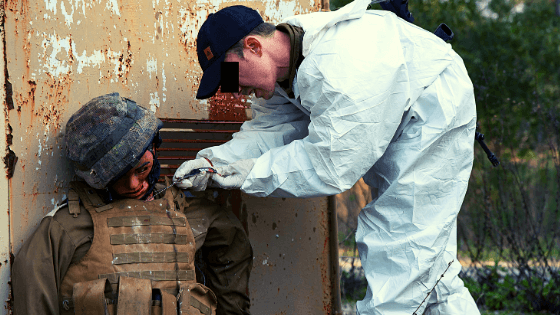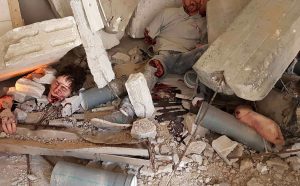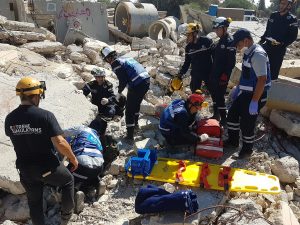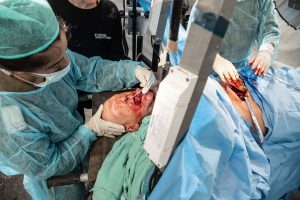The dog tag you wear on your neck when you go on a mission… Hoping your comrades will never have to search for it in order to identify you… Hoping you will never have to manage a missing persons or casualty identification event.
But if this kind of event occurs, you need to know you are ready to complete such a task. Your team depends on it, and so do the families of your fallen comrades.

This responsibility can occur as a result or as part of an extreme incident (learn about the characteristics of such an event here).
Any event is considered extreme if it:
- Includes numerous casualties
This is the case with a terror attack, large accidents, or natural disasters (tornadoes, earthquakes).
- Creates logistical and operational challenges
If we take the example of 9/11, that one was a massive challenge from the point of view of operational and logistical management. Another example could be an earthquake that destroys all points of access to the affected area, which in itself is a logistical challenge that requires fast thinking and innovative solutions.
- Creates difficulty in understanding the situation at hand
What has actually happened? What is going on at the scene? How many casualties are we talking about? Which casualties are certainly dead and which may be missing or kidnapped?

The casualty identification mission takes place in a very confusing environment. You have no answers to questions you might be asking yourself. Everything might feel unfamiliar. We’re not talking just about disturbing sights like bodies or body parts; we’re talking about visually impacting elements which also have an effect on the mind. It can be very challenging just to grasp the size of the event, understand what is happening or why.
For example, when a bus explodes, there might be bodies all over the place. Some of them might be disfigured, there might be body parts thrown away from the bus. The forensics team responsible for collecting evidence from the scene and “cleaning” the area might experience an array of emotions just because what has happened is difficult to grasp.

These are just some of the questions you could be asking yourself during or immediately after an extreme incident. There are some guidelines on what to do, but each extreme event is unique and unfortunately none of them come with a user’s manual.
You need to think fast, come up with solutions, deploy teams or go to the scene and figure out the next steps as you go. We discuss more about the challenges of managing a missing persons & casualty identification event below.
- The “time dimension” shrinks
This is a world where news travels instantly. Videos, photos, live video distribution on social channels, all tend to give birth to numerous fake news.
Civilians are bombarded with them or they themselves can be the ones who create them since nowadays almost everyone has access to a smartphone and can distribute live videos from the scene of an event.
However, this web of false or incomplete news often reaches the families of those affected and can cause a lot of pain.
What are the challenges of a missing persons & casualty identification event?
As mentioned above, one of the main struggles is that each event is unique but at the same time it requires a fast reaction, a good plan thorough implementation.

Here are some of the challenges that occur during a missing persons and casualty identification event:
How to delineate the affected area
You want to outline the affected zone as accurately as possible in order to:
- Use your resources to the maximum in a relevant space (you want to avoid searching in large, empty areas)
- Not miss any findings

How to manage the search
You will have a team, or you will be part of the team. Each team member needs to know what their responsibilities are for the mission to be successful – but how do you determine what they need to do?
There are several procedures that can help you outline a plan for the missing persons and casualty identification event.

How to scan the affected area
Going back to the first point, once you determine how spread out the affected area is, you need to decide how you and your team will conduct the search.
Usually, the event has a large diameter, so you will have to delineate a perimeter where you and/or your team conduct the search.

However, things may be scattered beyond that perimeter, which means you cannot cover everything all the time.
These being said, you still need to make sure that you collect all the evidence you can find and tag and label everything.
The details are less important for the sake of this article (we will talk all about this during your training). What you need to take away from this subpoint is that there is an entire forensics process involved and this is why training is crucial in these situations.
Managing labeling and classification
You will need to determine who does what and how much time you have to do it. Labeling and classification are extremely important for the investigations that follow after the event and can provide important information for forensic experts.

Cleaning the area
You need to ensure that the area is cleaned as soon as possible. There is a risk that, if not cleaned quickly, you might cause moral damage to the public.
Let’s use an example: the 2005 terror attack in London on a double-decker bus left the city center paralyzed. In addition to that, there was another attack on the subway, so aggressive that it was called a “subterranean bloodbath”. In total, more than 300 people were wounded. The debris was left lying there for days, which led to a traumatic experience for the citizens.
It is not healthy for the public to be shown these sights for a prolonged period. The cleaning activities should be fast, ensuring no harmful sights are left behind for the citizens to see.

The need to identify & mark findings vs the need to clean off the affected area
There is always tension between these two tasks. In the case of a terror attack, for example, you want to clean the area as soon as possible so as not to leave a “mental scar” on the population. In the case of a natural disaster, the area needs to be cleaned fast because there is a high risk of contamination.
How to manage a missing persons & casualty identification event
Train for it
The best way to make sure that you and your team know how to manage a missing persons & casualty identification event is to train for such an event. You need to learn and practice regularly so that the procedures become second nature.

Moreover, you need to ensure that all the teams involved in the management of the event know how to work together. For example, the missing persons units and the casualty identification units should know how to collaborate. Very often, their missions collide.
Consider religious sensitivities
A casualty identification event implies handling bodies and/or body parts. This bears religious sensitivities which need to be addressed. Casualty identification specialists need to be aware of these sensitivities or they should at least know how to ask the right questions in order to learn about them.
Keep it fast and simple
A DNA test is reliable, but it is sophisticated and might require comparison with the DNA of a family member. This takes time and is expensive.
On the other side, a fingerprint ID (bio-metric ID) is simpler, faster, and cheaper and can help you conduct a computerized identification process.


Get ready for a missing persons and casualty identification event now
If you are a first responder, serve in the army or in any department that deals with missing persons and casualty identification events, then you need to make sure that you participate in regular trainings for such events.
Tip: When choosing the company to train you, look for someone who has years of field experience in casualty identification.
Our team of CSI experts served in the IDF (Israeli Defense Force) & the Police Forensic Unit for years.
As a result, we have developed innovative methods and techniques for identifying casualties. Our fast, focused and efficient process has a high probability of success. We will guide your organization through the entire process of teaching casualty identification from preparing the right program, through courses and training.
GET IN TOUCH
Contact Extreme Simulations now to book a complete training session





